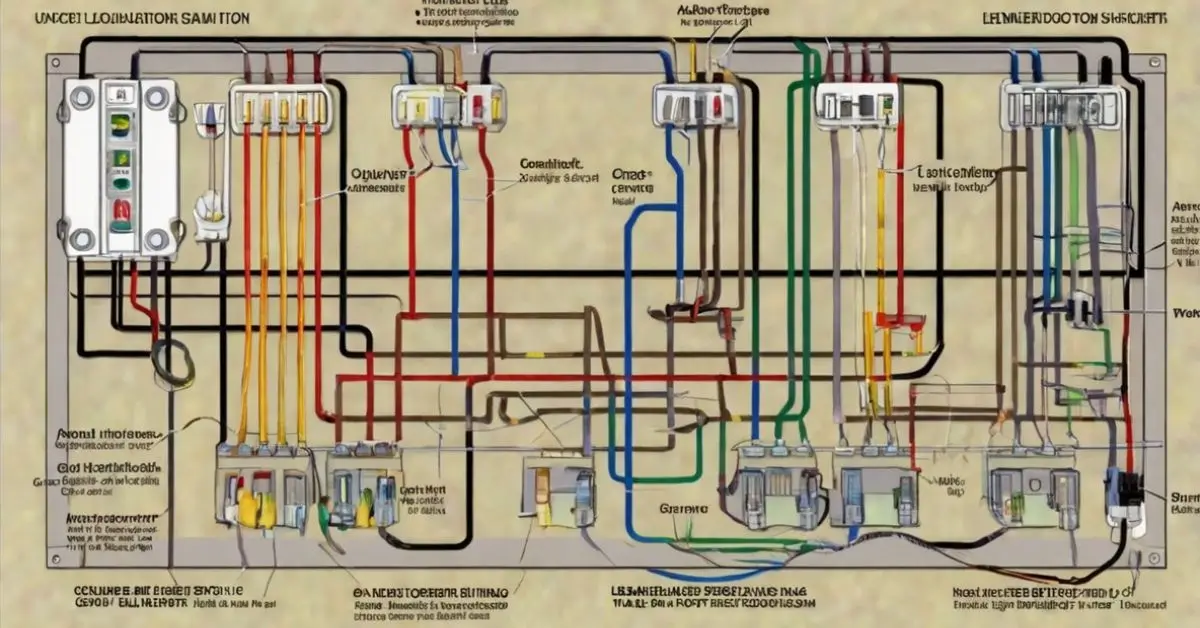The 4 wire trailer wiring diagram is a foundational aspect of trailer towing, especially for light-duty trailers. From boat trailers to small utility haulers, understanding this simple yet effective wiring configuration ensures legal compliance, safety, and convenience on the road. Whether you’re installing a new harness or troubleshooting faulty trailer lights, learning the ins and outs of the 4 wire system is essential for every trailer owner.
This in-depth guide covers everything you need to know about the 4 wire trailer wiring diagram, including color codes, wiring functions, installation steps, advantages, common mistakes, troubleshooting, and a detailed comparison with 5, 6, and 7 wire setups.
What Is a 4 Wire Trailer Wiring Diagram?
The 4 wire trailer wiring diagram refers to the basic wiring configuration used to power the essential lights on a trailer. It consists of four wires responsible for lighting functions like running lights, brake lights, and turn signals. This system is typically used for trailers that do not have electric brakes, reverse lights, or auxiliary power.
The Four Wires Explained
White Wire – Ground
The white wire is the ground wire and must be securely connected to the trailer frame.
Brown Wire – Tail/Running Lights
This wire powers the tail lights and clearance lights that remain on while driving at night.
Yellow Wire – Left Turn Signal & Brake Light
This wire controls both the left turn signal and left brake light.
Green Wire – Right Turn Signal & Brake Light
Similar to the yellow wire, this wire activates the right turn and brake lights.
These four wires are usually connected via a 4-pin flat trailer connector.
Why Use the 4 Wire Trailer Wiring Setup?
Using the 4 wire trailer wiring diagram provides simplicity, cost-effectiveness, and meets legal road lighting requirements for basic trailer types. It’s a go-to solution for:
- Small boat trailers
- Utility trailers
- Jet ski trailers
- Motorcycle haulers
Benefits of the 4 Wire Trailer Wiring Diagram
- Ease of Installation: Requires minimal tools and wiring knowledge.
- Compatibility: Matches most light-duty trailers and older vehicles.
- Affordable: Fewer wires mean less material cost and labor.
- Legally Compliant: Covers required lighting functions in most regions.
Tools and Materials Needed for Installation
To install or repair a 4 wire trailer wiring diagram, you’ll need the following tools and supplies:
- 4-pin flat connector
- Wire stripper/crimper
- Heat shrink tubing or electrical tape
- Zip ties or clamps
- Circuit tester or multimeter
- Mounting brackets and screws
- Protective wire loom (optional)
Step-by-Step Installation Guide
Step 1 – Disconnect Battery
Before working with trailer wiring, always disconnect the vehicle’s battery to prevent accidental shorts or shocks.
Step 2 – Strip Wires
Strip about half an inch of insulation off each wire for both the trailer and towing vehicle.
Step 3 – Match and Connect Wires
Use the following color-matching standard:
- White to White (Ground)
- Brown to Brown (Tail Lights)
- Yellow to Yellow (Left Turn/Brake)
- Green to Green (Right Turn/Brake)
Use a crimping tool or solder to secure each connection.
Step 4 – Seal Connections
Cover the connections with heat shrink tubing or wrap with electrical tape to prevent water intrusion and corrosion.
Step 5 – Ground the White Wire
Attach the ground wire to the trailer’s metal frame using a self-tapping screw or grounding bolt.
Step 6 – Test the System
Reconnect the battery and test all light functions using a circuit tester or by connecting to the towing vehicle.
Wiring Diagram Visual Reference
While this article does not include actual images, here is a textual representation of the 4 wire trailer wiring diagram:
White —> Ground to Trailer Frame
Brown —> Tail/Running Lights
Yellow —> Left Turn Signal/Brake
Green —> Right Turn Signal/Brake
Each of these wires connects to the corresponding trailer light or ground point to complete the circuit.
Comparison Chart: Trailer Wiring Systems
| Feature | 4 Wire System | 5 Wire System | 6 Wire System | 7 Wire System |
| Ground | Yes | Yes | Yes | Yes |
| Tail/Running Lights | Yes | Yes | Yes | Yes |
| Turn Signals | Yes | Yes | Yes | Yes |
| Brake Lights | Yes | Yes | Yes | Yes |
| Reverse Lights | No | Yes | Yes | Yes |
| Electric Brakes | No | No | Yes | Yes |
| Auxiliary Power | No | No | No | Yes |
| Best For | Small trailers | Boat trailers | Medium utility trailers | RVs and large trailers |
This comparison highlights the functionality differences, helping you decide if the 4 wire trailer wiring system fits your needs.
Common Issues and Troubleshooting Tips
Even with a correct installation, trailer wiring issues can arise. Below are typical problems and their solutions:
No Lights Work
- Check the connector for corrosion
- Ensure a proper ground connection
- Inspect the vehicle’s trailer fuse
One Side Not Working
- Likely a broken yellow or green wire
- Inspect the turn signal bulbs
Dim or Flickering Lights
- Indicates a bad ground or corroded terminals
- Clean the ground point and re-tighten screws
Lights Work Intermittently
- Check for loose wires or connectors
- Secure wires with zip ties to prevent vibration damage
Upgrading from 4 Wire to 7 Wire
Although the 4 wire trailer wiring diagram is sufficient for many users, you may outgrow it if your trailer setup becomes more advanced. Consider upgrading if you need:
- Reverse lights for better backing visibility
- Electric trailer brakes for increased stopping power
- Auxiliary power for running additional equipment
In such cases, a 7-pin wiring harness would be more suitable.
Best Practices for Trailer Wiring Maintenance
Keeping your wiring in good shape ensures long-term functionality:
- Inspect regularly for frayed wires or corrosion.
- Clean connectors with contact cleaner to prevent rust.
- Use dielectric grease to resist moisture.
- Replace damaged wires immediately to avoid electrical failures.
By following these practices, your 4 wire trailer wiring diagram setup will remain reliable for years.
Real-World Use Cases for 4 Wire Trailer Wiring Diagram
Kayak and Canoe Trailers
Lightweight and simple, these trailers rarely need more than basic lighting.
Landscaping Trailers
Used for carrying equipment, they typically don’t require reverse or brake systems.
Jet Ski Trailers
Basic lighting is all that’s required for short hauls to and from water bodies.
Motorcycle Haulers
With no electric brakes, a 4 wire system handles the job efficiently.Each of these scenarios benefits from the ease and reliability of a 4 wire trailer wiring system.
Integrating With Tow Vehicles
Most vehicles that support towing have a built-in trailer wiring connector. If not, you can use a wiring harness converter to adapt your vehicle’s separate turn and brake signals into a compatible 4 wire output. Some vehicles may also require:
- A power module to handle additional current
- Wiring adapters for newer SUVs or trucks
- Trailer light relays to prevent dashboard errors
Legal Considerations and Safety Compliance
In many regions, having operational tail, brake, and turn lights is a legal requirement for trailers. The 4 wire trailer wiring system covers all these legal necessities. However, to remain compliant:
- Check local vehicle codes
- Verify lighting brightness meets DOT regulations
- Ensure all lights are visible during both day and night
Environmental Protection for Your Wiring
Exposure to rain, road salt, and sunlight can wear down trailer wiring over time. Here’s how to protect your 4 wire trailer wiring system:
- Use marine-grade wiring for waterproof durability
- Wrap wires in protective looms or conduit
- Routinely apply sealant to connection points
Customizing Trailer Lights with 4 Wire System
Want a bit more style while sticking to a 4 wire system? You can install:
- LED tail lights (lower power draw)
- Sequential turn signals (with built-in circuitry)
- Decorative side marker lights (tied to the brown wire)
These enhancements improve visibility while keeping within the boundaries of the 4 wire trailer wiring diagram.
Conclusion
Mastering the 4 wire trailer wiring diagram equips you with the skills to maintain, install, and troubleshoot one of the most widely-used trailer wiring systems. With just four wires, you ensure that your trailer stays visible and compliant on the road. From its straightforward installation to reliable performance, this system is a favorite among DIYers and professional haulers alike.
If you own or operate a small trailer, learning this wiring configuration is a must. Keep your tools ready, connections secure, and lights bright. The open road awaits—safely and legally lit.
FAQ’s:
1. How do I know if my trailer uses a 4 wire system?
Check the connector—if it’s a flat 4-pin plug with four wires, it uses a 4 wire system.
2. Can I use LED lights with a 4 wire trailer wiring diagram?
Yes, as long as the LEDs are compatible with standard 12V systems.
3. What’s the most common issue with 4 wire trailer wiring?
A bad ground connection is the most frequent problem, often causing all lights to fail.
4. Do I need to fuse the wiring?
The tow vehicle typically has fuses for the trailer circuits. Adding inline fuses for extra protection is optional but recommended.
5. Is it okay to splice wires when installing the harness?
Yes, as long as the splices are well-crimped, sealed, and insulated properly.
6. Can I run additional lights off the 4 wire system?
Yes, but be cautious not to exceed the current limits of your towing vehicle’s lighting circuit.












